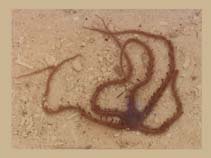Ophiomastix annulosa (Lamarck, 1816)
Chain-link brittle star| Native range | All suitable habitat | Point map | Year 2050 |

|
| This map was computer-generated and has not yet been reviewed. |
| Ophiomastix annulosa AquaMaps Data sources: GBIF OBIS |
Classification / Names Common names | Synonyms | CoL | ITIS | WoRMS
| Ophiacanthida | Ophiocomidae
Environment: milieu / climate zone / depth range / distribution range Ecologia
Associati a barriera corallina; distribuzione batimetrica 4 - 11 m (Ref. 81187). Tropical
Distribuzione Stati | Aree FAO | Ecosystems | Presenze | Introduzioni
Indo-West Pacific: from Maldives to China.
Length at first maturity / Size / Peso / Age
Maturity: Lm ? range ? - ? cm Max length : 2.4 cm WD maschio/sesso non determinato; (Ref. 87041)
Depth information reported for China (Ref. 81187). Size refers to disk diameter (Ref. 87041). Found beneath coral slabs and in holes and crevices. Possesses enlarged, modified, venomous spines (Ref. 800). Subtidal. Association with Ophiomastix scolopendrina may serve as its strategy in obtaining food from the host's arms (Ref. 102356).
Life cycle and mating behavior Maturità | Riproduzione | Deposizione | Uova | Fecundity | Larve
Members of the class Ophiuroidea are mostly gonochoric, others are protandric. Fertilization is external. Brooding is common, bursae is used as brood chambers where the embryos develop into juveniles and later crawl out from the bursal slits. Life cycle: Embryos hatch into free-swimming planktotrophic larvae and later metamorphose into tiny brittle stars which sink down the bottom where they grow into adult form.
Main reference
Bibliografia | Coordinatore | Collaboratori
Schoppe, S. 2000. (Ref. 800)
IUCN Red List Status (Ref. 130435)
CITES status (Ref. 108899)
Not Evaluated
CMS (Ref. 116361)
Not Evaluated
Threat to humans
Harmless
Human uses
| FishSource |
Strumenti
Informazioni ulteriori
Age/Size
Accrescimento
Length-weight
Length-length
Morfologia
Larve
Abbondanza
Accrescimento
Length-weight
Length-length
Morfologia
Larve
Abbondanza
Fonti Internet
BHL | BOLD Systems | CISTI | DiscoverLife | FAO(Publication : search) | Fishipedia | GenBank (genome, nucleotide) | GloBI | Gomexsi | Google Books | Google Scholar | Google | PubMed | Tree of Life | Wikipedia (Go, ricerca) | Zoological Record
Estimates based on models
Preferred temperature
(Ref. 115969): 24.9 - 29.3, mean 28.4 (based on 2609 cells).
Price category
(Ref. 80766):
Unknown.



